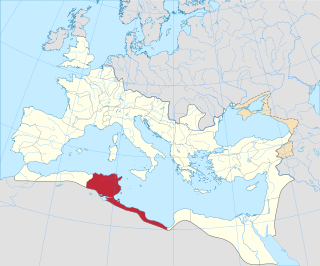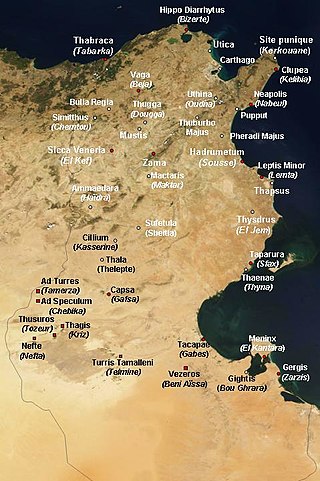
Byzacena was a Late Roman province in the central part of Roman North Africa, which is now roughly Tunisia, split off from Africa Proconsularis.

The name early African church is given to the Christian communities inhabiting the region known politically as Roman Africa, and comprised geographically somewhat around the area of the Roman Diocese of Africa, namely: the Mediterranean littoral between Cyrenaica on the east and the river Ampsaga on the west; that part of it that faces the Atlantic Ocean being called Mauretania, in addition to Byzacena. Thus corresponding somewhat to contemporary Morocco, Algeria, Tunisia and Libya. The evangelization of Africa followed much the same lines as those traced by Roman civilization. From the late fifth and early sixth century, the region included several Christian Berber kingdoms.

Musti or Mustis was an ancient city and bishopric in the Roman province of Proconsular Africa, now in northern Tunisia. Its ruins, called Mest Henshir, are about eight miles from Dougga, near Sidi-Abd-Er-Rebbou. It is also a Catholic titular see.

The Catholic Church in Tunisia is part of the worldwide Catholic Church, under the spiritual leadership of the Pope in Rome.

Téboursouk is a town and commune in the Béja Governorate, Tunisia. It is located at 36° 27′ 26″N, 009° 14′ 54″E.

Thignica was a town in the Roman province of Africa Proconsularis. It served as a Latin Catholic titular see.

Pupput, also spelled "Putput", "Pudput", "Pulpud" and "Pulpite" in Latin, sometimes located in Souk el-Obiod ou Souk el-Abiod, is a Colonia in the Roman province of Africa which has been equated with an archaeological site in modern Tunisia. It is situated on the coast near the town of Hammamet, between the two wadis of Temad to the north and Moussa to the south. Much of the Pupput is buried under modern holiday developments which have been built over the major part of the site.

Aggar was a town and bishopric in the Roman province of Byzacena. One of two cities in the area, it left vast ruins that are now called (Henchir) Sidi Amara. These edifices are situated in the plain of Siliana, around 60 kilometres east of Maktar.

Abbir Maius also known as Abbiritanus was a Roman and Byzantine-era civitas (city), later municipium, in the Roman province of Africa proconsularis.
Avioccala was a Roman and Byzantine era town in the Roman province of Africa Proconsularis in northern Tunisia. The town lasted from 30BC to about 640AD, and has been tentatively identified with the stone ruins at Sidi-Amara, Tunisia.

Semta was a Roman era Municipium also known as Augustum Semta in Africa Proconsularis that is tentatively identified with ruins at Henchir Zemba (Dzemda) Carthage, Tunisia near the Oued el Kebir 20 km (12 mi) southwest of Zaghouan at 36.269282, 9.887345.

Thucca Terenbenthina, also known as Thugga, was an ancient Roman-Berber town in the province of African Proconsularis. In late antiquity, it was made a municipium of the province of Byzacena. Thucca Terenbenthina is identified with ruins located in the modern town of Dougga, Tunisia.

Bijga, also known as Henchir-Bijga, is a place in Tunisia, North Africa, near the city of Tunis.
Cincari was a Roman era civitas of Africa Proconsularae a town which has been tentatively identified with the ruins of Henchir Tengar in today's northern Tunisia. The ruins at Bordj Toum have also been proposed as an alternative for the town.

Sinna was a Roman era civitas of the Roman province of Africa Proconsularis.
Furni, also known as a Furnos Maius and Ain-Fourna, was a Roman era civitas of the Roman province of Africa Proconsularis on the Oued Kibira tributary of the Meliane River.

Sululos was a Roman era Municipium of the Roman province of Africa Proconsularis that flourished from which flourished from 30 BC - AD 640. The ancient town was officially known as Municipium Septimium Aurelium Severianum Apollinare Sululitanum and is tentatively identified with ruins at Bir-el-Heuch, (Bir-el-Ach) 36.461372, 9.605158 in what is today Tunisia.

Henchir-Aïn-Dourat, also known as Ad-Duwayrat or Henchir Durat, is a former Roman–Berber civitas and archaeological site in Tunisia. It is located at 36.767496n, 9.524142e, in the hills just north of Toukabeur and 15.3 km (9.5 mi) from Majāz al Bāb. It was an ancient Catholic diocese.
Henchir-Ed-Douamès is an archaeological site and locality in Tunisia, located 120 km southwest of Tunis, in the Governorate of Béja, near Dougga. It is identified with the ancient city of Uchi Maius.

Muzuca was a Roman Town of the Roman province of Byzacena during late antiquity. The town has tentatively been identified with the ruins at Henchir-Besra in modern Tunisia. Very little is known of the city, though in situ epigraphical evidence gives us the name and that in late antiquity it achieved the status of Municipium.













